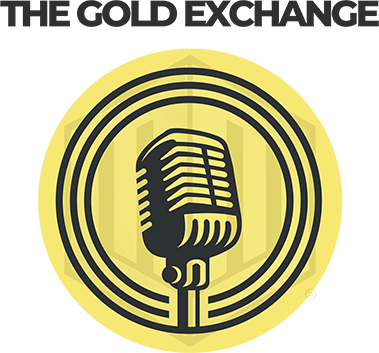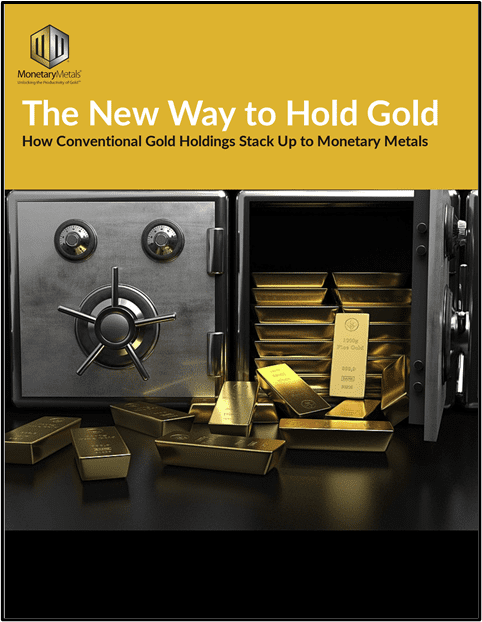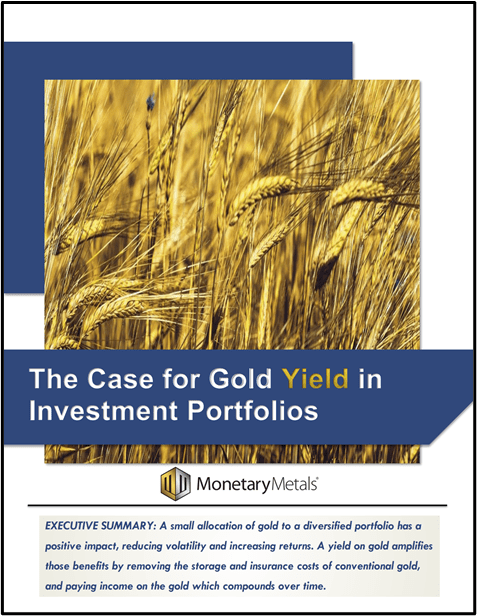Transcript
CEO Keith Weiner explains on the Gold Exchange podcast what a silver bond is, why the current silver bond offering from Monetary Metals is so historic, and how to think about dollar vs metal yields.
Follow Monetary Metals on X: @Monetary_Metals
Additional Resources
Earn 12% in our Silver Bond offering
Earn Interest on Gold and Silver
Earn Passive Income in Gold and Silver
Podcast Chapters
00:00 – CEO Keith Weiner
00:11 – Welcome to the Gold Exchange podcast
00:35 – Explaining Precious Metals Bonds
01:29 – Understanding Fixed Income in Precious Metals
02:50 – History of Gold and Silver Bonds
06:50 – Details on the Silver Bond Offering
07:51 – Hedging and Financials for Miners
09:28 – How to Invest in the Silver Bond
09:48 – Unlocking a yield on precious metals
Transcript
Ben Nadelstein:
Welcome back to the Gold Exchange podcast. My name is Ben Nadelstein. I’m joined by the CEO and founder of Monetary Metals, Keith Weiner. Keith, how you doing today?
CEO Keith Weiner:
Doing all right. Doing all right.
Ben Nadelstein:
Keith, Monetary Metals is offering a historic silver bond offering. I want to go through that with you today. First off, what is a silver bond or a gold bond? And how is that different from, you know, a regular dollar denominated bond that most people are aware of?
CEO Keith Weiner:
Well, dollar denominated bond, you know, let’s say you buy $1,000 worth. So the, the principal is denominated as $1,000. The principal is eventually repaid as $1,000. And the interest, let’s say it’s 3%. You get $30 a year in a gold bond. It’s denominated in ounces, the same thing with a silver bond. So we have a silver bond coming up, as you alluded to, it is denominated in silver with principal and interest paid in silver, not in dollars. So regardless of what the silver price may do, you know how many ounces you’ve got?
Ben Nadelstein:
And this is called a silver or a gold fixed income opportunity, because that interest rate is fixed in ounces over the duration of the term. And usually when people think about different interest rates, they also factor in real interest rates, which I know we might have a slight objection to. But so how do we think about that, a dollar interest rate versus a gold interest rate or a silver interest rate, even if they’re the same number, how do those actually difference?
CEO Keith Weiner:
The Fed states as its official policy that its intention is to devalue the dollar at 2% per year. So its not really that simple for the Fed, and its not really that simple to figure out what exactly that means. But in a certain sense, one wouldnt be that far off by saying, okay, just hack 2% off of whatever dollar interest rate youre getting, and thats a closer to the real interest rate. And of course, gold can’t be devalued or debased. And so the gold interest rate is, you know, what does the car mirror say? Usually on the passenger side, objects in this mirror are larger than they’re closer than they appear. Well, the gold interest rate is higher than it appears, because that’s in the form of money that can’t be debased versus the dollar, where it’s their stated official policy to debase it. And they tell you exactly how much? 2%.
Ben Nadelstein:
When we talk about a gold or a silver bond, this is a historic offering, because most bonds, or almost all bonds, are denominated in some form of paper currency, whether that’s a dollar, euro, yen, yuan, so forth. So tell us a bit about the history of gold and silver bonds. Clearly, the United States and other countries used to be on a gold and silver standard at some point during their history. When was the last gold bond or silver bond? And why is this offering so historic, as you say?
CEO Keith Weiner:
You said that most bonds are denominated. Actually, all of them are, except for monetary metals, products. We’re unique. That’s what makes us different. The last gold bond, as far as any research I’ve been able to come up with, and I’ve been saying this since our first gold bond in 2020, which was the first gold bond in the world since 1933. So I believe that puts it in 87 years. So 1933 is the year that should go down in infamy. That’s when President Roosevelt destroyed the gold standard, voided all the gold clauses, including payment on coupons, and forced everybody to deal with paper currency that had become irredeemable to american citizens. Now, technically, it was still redeemable to foreign governments on the eve of World War Two. I don’t think that really was coming up very often. I think they were shipping their gold to the US, not the other way around, as they could all imagine, war ravaged countryside and enemy soldiers coming in, taking gold and things like that. But after the war, they did start to redeem, and then ultimately, that led to Nixon pounding home the final nail into the coffin as a gold standard, 1971, but really was dead for Americans, 1933.
Now, silver is a bit different. I think the last time there was a silver bond was much, much, much earlier than that. And you have to look at the history of the United States and our monetary system to sort of understand that. I haven’t fully researched this yet, so there’s a possibility that something happened more recent than the year I’m about to give. So, 1790, we had a coinage act that slightly overvalued silver relative to gold. Now, when you overvalue something as coinage or money and undervalue another thing, Gresam’s law says, the one that’s undervalued as money will not come to market as money, and the one that’s overvalued will flood in that effectively. Even though they called it bimetallism, effectively put the US in a silver standard because they fixed it at 15 to one in the Coinage act, the world market price was closer to 15.5 to one. And so 15 to one overvalued silver were on a silver standard, as was the UK. And the term pound, which is still the name of their currency today, denoted a pound of silver. And look at how thats been devalued. A pound today is what, $1.27 or something?
A single troy ounce of silver is $30. Boy, has that currency come down. But May 1834, they reversed it. It was the new Coinage act, and then they valued it 16 to one, which undervalued the silver as money. And that was really part of the trend of demonetizing silver. The UK had, I believe, already demonetized it. And so that puts the US, even though it was still officially bimetallism, that officially or unofficially defacto put the US on a gold standard. And that form of money is what would end up in the banks. And I think the bond market is whatever form of money the banks had. So I suspect it really wasn’t either any silver bonds, or certainly it would have been dwindling rapidly after 1834. And so our silver bond now would potentially be the first silver bond in 190 years. So even more historic than our first gold bond was in 2020.
Ben Nadelstein:
So, Keith, now let’s discuss the specifics of this silver bond so we understand maybe how a silver bond works. You have a silver principal and silver interest payments. What is the duration of the bond, the interest payments, and how will this specific silver bond work?
CEO Keith Weiner:
So it’s a three year maturity payments are quarterly, starting from the very first quarter, it was 12% interest. That means if you put 1000oz into it, you’re getting 120oz of interest in year one. Mechanically, how does that work? Well, we’re lending to a mining company that produces lead, zinc, silver ore, and so the silver content is sufficient to pay the interest of the principal to amortize the bond. So they’re literally paying, paying us by pulling the silver out of the ground it’s being paid out of. Part of the new silver production is paying off the investors.
Ben Nadelstein:
And explain the hedging or price volatility component that a miner now no longer has to worry about when they finance their asset. Silver in a liability that is the same asset, which is, again, silver. So silver on silver, how does that impact hedging and financials as well?
CEO Keith Weiner:
So in a conventional loan to a miner, let’s say they borrow $30 million, which is roughly the dollar value of this million ounces of silver bond. But let’s say they denominated in dollars. That means they owe $30 million back. Now, at the moment, that’s a million ounces. But if the silver price were to drop, let’s say by 50% to $15, they’d actually have to mine 2 millionoz to repay that dollar loan. So there’s a mismatch between the loan, which is dollars. So that’s the liability is mismatched to the asset, which is silver. Normally you wouldn’t want that kind of exposure, so you’d hedge the silver price. And that way, if the silver price goes down, you’re covered. But in our case, because the loan is denominated in silver, and silver is the thing they can produce, silver is the thing they control. They know, okay, we’re going to produce this many ounces, and therefore we can pay off this loan. Then there’s no hedging because the asset, which is silver, coming out of the ground, and the liability, which is silver, owed to the bondholders match. And that’s the ideal for any corporate borrower match or assets and liabilities, and you sleep better at night.
Ben Nadelstein:
So Keith, final question here. Someone owns silver. They are an accredited investor, and they might be interested in signing up for this silver bond opportunity. Where can they find out more?
CEO Keith Weiner:
Monetary-Metals.com
Ben Nadelstein:
CEO Keith Weiner, thank you so much!
Additional Resources for Earning Interest in Gold
If you’d like to learn more about how to earn interest on gold with Monetary Metals, check out the following resources:
In this paper, we look at how conventional gold holdings stack up to Monetary Metals Investments, which offer a Yield on Gold, Paid in Gold®. We compare retail coins, vault storage, the popular ETF – GLD, and mining stocks against Monetary Metals’ True Gold Leases.
The Case for Gold Yield in Investment Portfolios
Adding gold to a diversified portfolio of assets reduces volatility and increases returns. But how much and what about the ongoing costs? What changes when gold pays a yield? This paper answers those questions using data going back to 1972.






